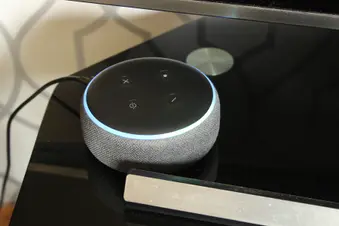
Technological advances have led to many tools that help with low vision. These devices, apps, and other technology may help you live more independently with geographic atrophy (GA).
Smartphones and Computer Tools
Your phone, tablet, or computer can help you with everyday tasks. For example, you can install computer software or download a smartphone app that magnifies what’s on your screen or narrates what you’re looking at.
Here are some of the latest low-vision tools you can pair with your personal devices.
Smartphone settings. You can customize your smartphone, tablet, and computer to better fit your vision needs. For example, try using voice commands, or change your settings to display larger fonts and higher contrast. Go to your device’s settings and look for accessibility options to find choices like voiceover, spoken content, and audio descriptions.
Identification apps. Many apps can help you identify things more easily.
- EyeNote scans paper money and tells you the value, so you know whether you’re looking at a $5 bill or a $500 bill.
- Seeing AI connects to your camera to help you identify things you may run into every day, from household objects to close friends. It narrates what you’re looking at and can also describe things stored on your phone, such as photos and documents.
- Be My Eyes connects you with a sighted volunteer who can read food labels or find something you lost in your house through a live video chat.
Navigation apps. Find your way around with the help of GPS and navigation apps.
- NavCog gives you turn-by-turn directions.
- BlindSquare describes your surroundings and tells you when you’re near a point of interest or street intersection.
- Rideshare apps like Uber and Lyft work with the company Aira to help people with low vision connect to an agent to start and manage rides.
Shopping, entertainment, and organization apps. Many user-friendly apps can help you shop, read, and do things you enjoy more easily.
- A talking calculator tallies numbers and reads the answers aloud.
- Note-taking apps like Evernote and AccessNote help you make to-do lists, take notes, and record voice reminders.
- The audiobook app Audible gives you access to more than 150,000 downloadable recorded books.
- The shopping app Blind Bargains can search the web for deals on the latest talking products and gadgets.
Magnifying Tools
Magnifying devices now come in many shapes and sizes.
Portable magnifiers. You have many options for portable magnifiers, which light up and magnify books, projects, and other everyday objects. Some are handheld, so you can use them at the grocery store or a restaurant to read labels and menus easier. Others are made for your desktop and connect to your computer. You can choose between different levels of magnification. Some come with a contrasting color option.
Camera magnifiers. A video magnifier uses a camera system to take real-time video and project it onto a screen. You can direct the camera at something you’re working on, such as a knitting project, and it sends a magnified image to your TV screen so you can work in real time.
Telescopic devices. If you need to look at something in the distance, a telescopic lens may help you see it better. Telescopic lenses may help you read signs, recognize faces, and watch TV. You can choose from different sizes. Some are so small that you can attach them to your glasses.
Magnifying glasses. The right pair of glasses not only magnify what you look at but can also cut back on glare, build high color contrast, and shift the position of images so they’re in your visual field. Look for eyeglasses specially made for low vision.
Audio Tools
Audio is a handy tool to help you navigate your surroundings and help with daily tasks.
Speech-to-text. Instead of typing or writing something on your computer, tablet, or phone, try speech-to-text options, such as Google’s Voice to Text. Record what you want to write, and it types it on the page for you.
Text-to-speech. You can also do the opposite. Many software programs and smartphone apps convert text like emails or internet searches into speech so you can hear them aloud.
Audio recordings. Swap your notepad for an audio version. For example, use a portable voice recorder or voice recording app to keep track of your shopping list or to-do list.
Talking devices. Many everyday tools also come in talking versions:
- Blood pressure monitors
- Book players (available at the National Library Service for the Blind and Print Disabled)
- Thermometers
- Watches and clocks
Show Sources
Photo Credit: Kerry Gerdes / Getty Images
SOURCES:
Sam Dahr, MD, director, retina division, McGovern Medical School, UTHealth Houston.
American Academy of Ophthalmology: “30 Apps, Devices and Technologies for People With Vision Impairments.”
American Macular Degeneration Foundation: “Assistive Technology for Age-related Macular Degeneration.”
American Printing House for the Blind (APH), Connect Center, VisionAware: “Coping with Geographic Atrophy, the Advanced Stage of Dry Macular Degeneration,” “What Is Low Vision?”
Hope Vision Foundation: “The 7 Best Apps For People With Low Vision And Blindness.”
Lighthouse Guild: “Apps for Adults with Vision Loss.”